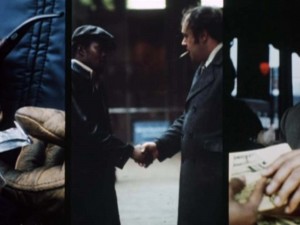He’s Got Some Bad Ideas in His Head
The first image the viewer is presented with in Taxi Driver, aside from theimage of a taxicab slowly slithering through the smoke from a sewer, is eyes. The eyes are those of the main character Travis Bickle—the man who would not take it anymore, the man who’s got some bad ideas in his head, God’s lonely man. In this shot, Travis’ eyes never stop drifting, as he never stops observing the hellish dumpster or open sewer, to quote the character himself, he has found himself trapped in and unable to climb out of. Travis’ eyes are lit with a distinct red tint, which is a direct color representation this hellish underworld, and is only one of many expressionistic techniques used in the film in order to depict a world as seen from the eyes of this isolated and disturbed taxi driver. These expressionistic techniques not only represent a world from a firsthand point-of-view, but also represent the very mental fabric of Travis. He, just like New York City, is a constant and ever worsening state of decay. In this sense, the film’s locale is manipulated to such a grand extent that it’s almost as if it becomes yet another character. New York City becomes Travis’ best friend, worst enemy, and only companion, whether he likes it or not.
These expressionistic techniques not only represent a world from a firsthand point-of-view, but also represent the very mental fabric of Travis. He, just like New York City, is a constant and ever worsening state of decay. In this sense, the film’s locale is manipulated to such a grand extent that it’s almost as if it becomes yet another character. New York City becomes Travis’ best friend, worst enemy, and only companion, whether he likes it or not.
Martin Scorsese’s expressionistic techniques splashed among a realistic, gritty background make it evident that Taxi Driver is a film that is quite psychological is nature. Other less overtly visually subjective techniques that make this evident are Travis’ voice-over monologues, which give an even more direct point-of-view along with the indication that what the audience is seeing is what the main character is seeing; the lengthy, more ordinary sequences of Travis driving his cab, which show him over and over again becoming engulfed in his surroundings and become one what this urban hell; the music, that is at times contradictorily soothing and chilling, representing his constant mental rollercoaster and giving the film a dream or trance-like quality. With these filmmaking choices, the audience is given an even more direct look into his consciousness. As the film progresses, the narration becomes more driven by anger and the music more intense as the anticipation of drastic action grows. The color red is also in effect during a pivotal scene  about an hour into the film, where Travis has a discussion outside of a cafeteria with a fellow taxi driver, Wizard, but are really unable to formulate any sort of real discussion. The scene represents Travis’ inability to fully connect with others, as well his growing unrest, which is emphasized when he tells Wizard, “I’ve got some bad ideas in my head.” The scene has a mood of intense desperation, and is lit with that familiar red tint, depicting Travis as a ticking time bomb and overshadowing a violent downfall.
about an hour into the film, where Travis has a discussion outside of a cafeteria with a fellow taxi driver, Wizard, but are really unable to formulate any sort of real discussion. The scene represents Travis’ inability to fully connect with others, as well his growing unrest, which is emphasized when he tells Wizard, “I’ve got some bad ideas in my head.” The scene has a mood of intense desperation, and is lit with that familiar red tint, depicting Travis as a ticking time bomb and overshadowing a violent downfall.
Although some may think of Taxi Driver as a realist film, it is not. The film is an impressive act of expressionism, which is defined as “an artistic style in which the artist seeks to depict not objective reality but rather the subjective emotions and responses that objects and events arouse within a person.” For its time, its manipulation of locale (1970s New York City) as well as editing and lighting in order to achieve such an effect are stunning. The city, consumed with decay at the time, served perfectly as a metaphor for a lonely man consumed with his own psychological decay and who, like the city, is unable to resist or fight said decay and has no choice but to watch himself collapse under the pressure of attempting to find a way out of the mess.
decay at the time, served perfectly as a metaphor for a lonely man consumed with his own psychological decay and who, like the city, is unable to resist or fight said decay and has no choice but to watch himself collapse under the pressure of attempting to find a way out of the mess.


